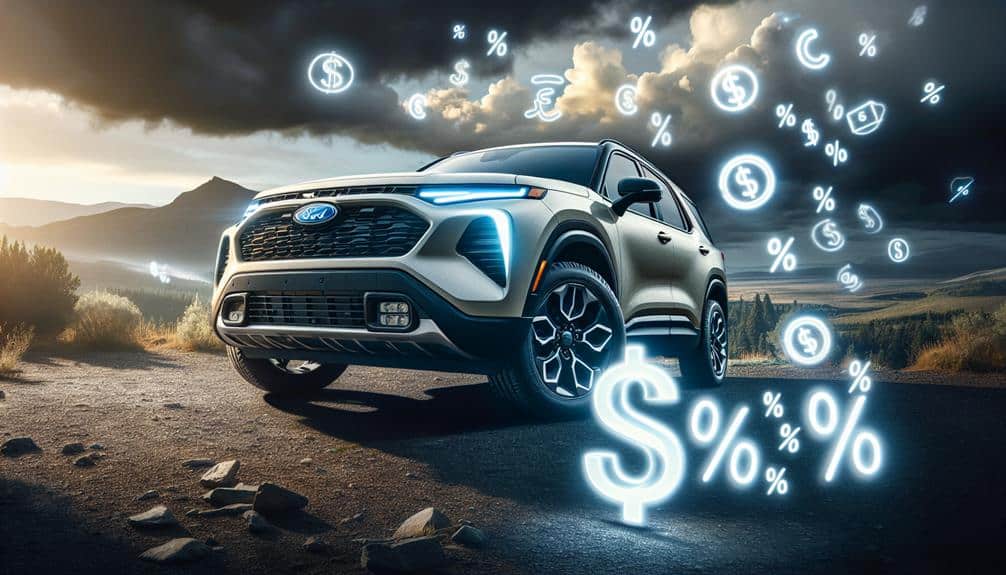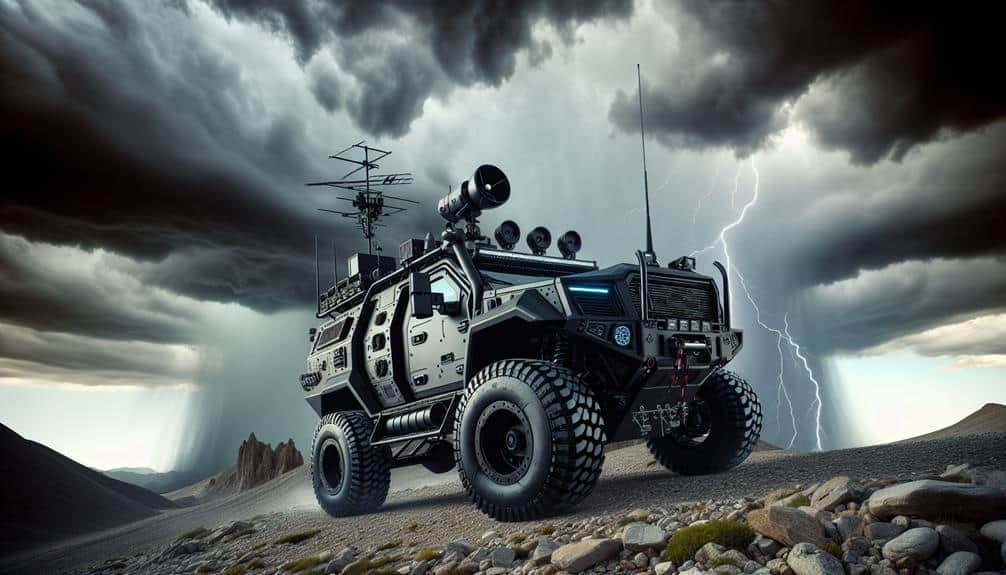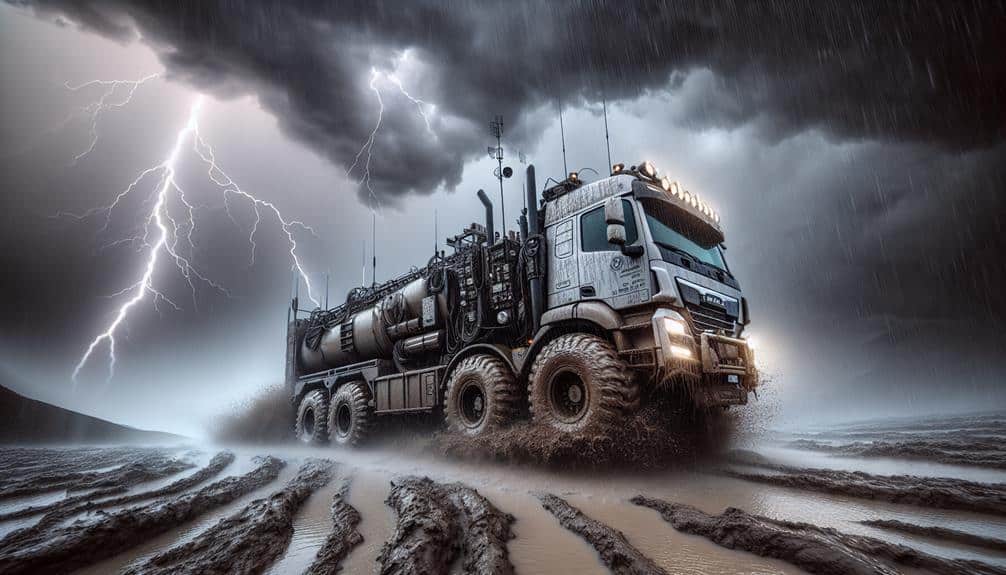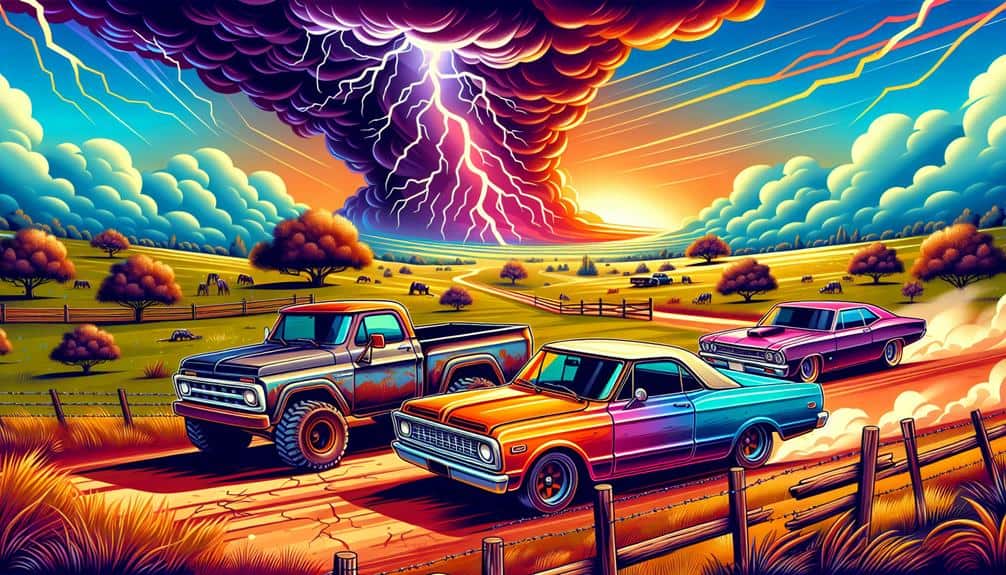Securing budget-friendly financing for storm chasing SUVs is vital, so we need to be strategic. We'll evaluate both secured and unsecured loans to find favorable terms, considering monthly affordability and long-term interest. Exploring credit unions often yields lower rates, while online lenders offer quick approval. Manufacturer incentives, like low-interest financing or lease deals, provide substantial savings. Government grants and SBA Disaster Assistance Loans are also crucial for stretching our budget. By comparing these options meticulously, we can make sure we don't compromise on essential features like durability and navigation systems. For further insights, let's analyze these strategies thoroughly.
Key Points
- Explore credit unions for lower interest rates and personalized customer service.
- Consider used SUVs to reduce initial investment and financing costs.
- Evaluate state-specific funding programs offering interest-free loans or grants.
- Compare interest rates and loan terms from multiple lenders for the best deal.
Understanding Your Financing Needs
Before exploring financing options, it's important to clearly define our budgetary constraints and specific requirements for a storm chasing SUV. We need to start by identifying the total amount we can allocate without compromising our emergency savings. It's crucial to maintain a financial buffer for unexpected expenses that might arise during storm chasing expeditions.
Once we've established our budget, let's consider the features our SUV must have. Durability, advanced navigation systems, and ample storage space for equipment are non-negotiable. This helps us narrow down the options and allows us to focus on vehicles within our price range.
Next, we should evaluate different payment plans. A well-structured payment plan can make a significant difference in managing our finances. We can compare monthly payment amounts, interest rates, and loan terms to find the most favorable conditions.
While doing so, it's essential to factor in insurance costs and maintenance expenses to avoid financial strain down the road.
Exploring Loan Options
When exploring loan options, we should meticulously analyze the various types of loans available to guarantee we secure the most favorable conditions for our storm chasing SUV. First, let's consider secured loans versus unsecured loans. Secured loans might offer lower interest rates since they're backed by collateral—usually the vehicle itself. However, this means the SUV could be repossessed if we default on payments.
Unsecured loans, while risk-free in terms of collateral, often come with higher interest rates.
Next, examining the loan terms is essential. We should aim for terms that balance monthly affordability with total interest paid over time. For instance, longer terms reduce monthly payments but increase the total interest paid. Conversely, shorter terms mean higher monthly payments but less interest overall.
Interest rates are a vital factor in our decision-making process. Shopping around for the best rates can save substantial amounts over the loan's life. It's wise to check offerings from banks, credit unions, and online lenders.
Additionally, our credit score plays a significant role in determining the interest rate we qualify for, so maintaining good credit is beneficial.
Leasing Vs. Buying
Evaluating the merits of leasing versus buying will further help us determine the most cost-effective strategy for acquiring our storm chasing SUV. Let's explore the financial benefits and weigh the pros and cons of each option.
Leasing offers lower monthly payments compared to buying, which can significantly enhance our cash flow. This flexibility allows us to allocate funds toward other storm chasing essentials. Leasing also keeps us driving newer models with the latest technology, which could improve our safety and performance in adverse weather conditions. However, the downside is the mileage restrictions and potential penalties for wear and tear, which are crucial factors given our usage.
On the other hand, buying a vehicle demands a higher initial outlay and higher monthly payments, but it also provides long-term savings. Owning the SUV means we can drive unlimited miles and customize the vehicle to better suit our needs without worrying about lease terms. Additionally, once the loan is paid off, we've a valuable asset that can be sold or traded in.
Ultimately, the choice between leasing and buying hinges on our priorities—whether we value immediate financial flexibility or long-term savings and complete ownership.
Credit Unions and Banks
Credit unions and banks offer distinct financing options that can greatly impact the overall cost and terms of acquiring our storm chasing SUV. Credit unions, often member-owned, typically provide lower interest rates and more personalized customer service compared to traditional banks. They're a solid choice for those of us looking for competitive rates and flexible repayment terms.
Banks, on the other hand, offer a wider array of financial products and services. They can be a great option if we prefer extensive online banking options and need access to larger loan amounts. However, banks often have stricter credit requirements and may charge higher interest rates.
For those seeking more freedom in financing, exploring online lenders and alternative financing options can be worthwhile. Online lenders frequently offer quick approval processes and competitive rates, making the process more efficient.
Additionally, peer to peer lending platforms and crowdfunding opportunities allow us to bypass traditional financial institutions altogether. These options can offer unique terms and potentially lower costs, but they come with their own set of risks and should be evaluated carefully.
Manufacturer Incentives

Manufacturers often provide special incentives such as rebates, low-interest financing, and lease deals to make their SUVs more attractive to buyers like us. These incentives can notably lower the overall cost of a storm-chasing SUV, making it easier for us to get behind the wheel without breaking the bank.
Cash rebates and discounts are direct reductions in the purchase price, often available during special promotions or end-of-year sales events.
When manufacturers offer low-interest financing, it allows us to spread the cost over several years without accruing substantial interest charges. This option is particularly appealing for those of us who prefer to own the vehicle outright eventually. Special promotions and deals, such as zero-percent financing for a set period, can further enhance affordability.
Leasing is another manufacturer-backed option that offers lower monthly payments compared to traditional financing. This can be an attractive alternative for those of us who value having the latest models with the latest technology.
Government Grants and Programs
We should consider government grants and programs as viable financing options for our storm chasing SUVs. Federal assistance opportunities often provide substantial funding, reducing our initial outlay.
Additionally, state-specific funding programs can offer tailored financial support, aligning with regional storm research priorities.
Federal Assistance Opportunities
Many storm chasers can greatly benefit from federal assistance programs designed to ease the financial burden of acquiring specialized SUVs. These programs specifically aim to enhance emergency preparedness and streamline disaster recovery efforts. By leveraging federal grants and low-interest loans, we can optimize our resources without compromising on the quality of our equipment.
The Federal Emergency Management Agency (FEMA) offers grants that cover a variety of disaster-related expenses, including those incurred by storm chasers. FEMA's Hazard Mitigation Grant Program (HMGP) is particularly useful, as it funds projects that reduce the risk of future disasters. For those of us committed to tracking severe weather, this means financial assistance for vehicles equipped with advanced meteorological tools.
Additionally, the Small Business Administration (SBA) provides Disaster Assistance Loans that can be used to finance storm-chasing SUVs. These loans come with favorable terms, making them an attractive option for our community.
State-Specific Funding Programs
In addition to federal assistance, state-specific funding programs offer tailored financial solutions for acquiring storm-chasing SUVs, enhancing our ability to respond effectively to severe weather events. Each state has unique grants and programs designed to address local needs and priorities, making them invaluable for our specialized requirements.
For instance, local scholarships can sometimes be leveraged to offset costs associated with training and certification for storm chasing, indirectly freeing up funds for vehicle acquisition. Furthermore, community grants often target initiatives that improve public safety and disaster preparedness. By tapping into these resources, we can secure essential equipment without straining our budgets.
Analyzing the financial landscape, we find that state programs frequently offer more flexible terms than federal options. They might provide matching funds, interest-free loans, or even outright grants, depending on the state's budget and disaster preparedness goals. This tailored approach ensures we get funding that aligns closely with our operational needs.
Tips for Saving Money

We should start by comparing interest rates from different lenders to guarantee we secure the lowest possible financing costs.
Additionally, opting for a used SUV can substantially reduce our initial investment and overall financial burden.
Compare Interest Rates
To save money on financing your storm chasing SUV, it's crucial to compare interest rates from various lenders meticulously.
First, we need to understand that different lenders offer varying loan terms based on our credit scores. A higher credit score often means lower interest rates, which translates to more savings over time. It's vital to gather quotes from multiple banks, credit unions, and online lenders to find the most competitive rates.
When analyzing these offers, we should look beyond just the interest rates. Consider the loan terms, such as the length of the loan and any associated fees. Longer loan terms might offer lower monthly payments, but they often come with higher overall interest costs. A shorter term might require higher monthly payments but could save us money in the long run.
Additionally, our credit scores play a pivotal role in determining the interest rates offered to us. By monitoring and, if necessary, improving our credit scores, we can access better financing options. Tools like credit score simulators can help us understand how different actions, like paying down debt or correcting errors on our credit reports, can impact our scores and, consequently, our loan offers.
Staying informed and proactive gives us the freedom to make the best financial decision for our storm chasing adventures.
Opt for Used
Why not consider opting for a used SUV to cut costs and maximize our storm chasing budget? By choosing a pre-owned vehicle, we can leverage significant budget benefits while still acquiring a reliable and capable SUV. The depreciation rate for new vehicles is steep, meaning a used SUV offers substantial savings without compromising on performance.
When evaluating used options, we must prioritize investigating the vehicle history. An in-depth vehicle history report can reveal previous accidents, maintenance records, and ownership history, ensuring we make an informed decision. This analytical approach helps us avoid potential pitfalls and costly repairs down the line.
Financing a used SUV also tends to be more favorable. Lenders often offer competitive interest rates for pre-owned vehicles, and the lower principal amount can make monthly payments more manageable. This financial flexibility aligns perfectly with our desire for freedom, allowing us to allocate more of our budget toward essential gear and travel expenses.
Additionally, modern used SUVs often come equipped with advanced safety features and technology, ensuring our storm chasing endeavors remain both safe and efficient. By opting for a meticulously chosen used SUV, we can enjoy the thrill of the chase without breaking the bank.
Frequently Asked Questions
How Do Insurance Costs Differ for Storm Chasing Suvs?
When we compare insurance for storm chasing SUVs, we see premium rates can be high due to risks. Coverage options vary, and deductible limits impact costs. Analyzing these factors helps us find the best insurance deal.
What Are the Maintenance Costs for a Storm Chasing Suv?
We acknowledge upfront costs are a concern, but let's break it down. Maintenance costs for a storm chasing SUV include repair costs and fuel efficiency. Regular upkeep guarantees reliability and freedom during unpredictable weather conditions.
Are There Specific Features to Look for in a Storm Chasing Suv?
We should prioritize safety features, durability, and off-road capabilities in a storm chasing SUV. Customization options are also essential for adapting to unpredictable conditions, ensuring we can navigate challenging terrains safely and efficiently while preserving our freedom.
How Can I Improve My Credit Score Quickly to Qualify for Better Financing?
It's funny how we all need quick tips sometimes! For fast credit repair, let's pay down high-interest debts, dispute errors, and avoid new loans. Better financing rates will follow, improving our financial freedom and opportunities.
What Are the Best Models of SUVS for Storm Chasing on a Budget?
When comparing the best brands, we recommend used SUVs like Toyota 4Runner and Subaru Forester for budget-friendly storm chasing. New models offer reliability but used options provide more financial freedom with lower depreciation and upfront costs.


